Part 1 of this list concluded with Marco Pantani’s destruction of Jan Ullrich in 1998. With the turn of the decade came a whole host of iconic moments and increased media coverage. Sadly, the whole era is tarnished by doping revelations but the protagonists still took part in some fierce battles. Immediately post-Armstrong we saw a predictable dip in excitement as the race transitioned into a new era. The blue touch paper was soon lit for Alberto Contador’s career and brothers Frank and Andy Schleck helped provide some of the greatest stages of all time. The ASO have become more creative and often tweak the formula from a pancake flat opening week. Moves have been made to make stages shorter or more interesting, and new climbs have been sought to freshen things up. Here’s five more great Tour de France stages.
Part 2: 2000 – 2015
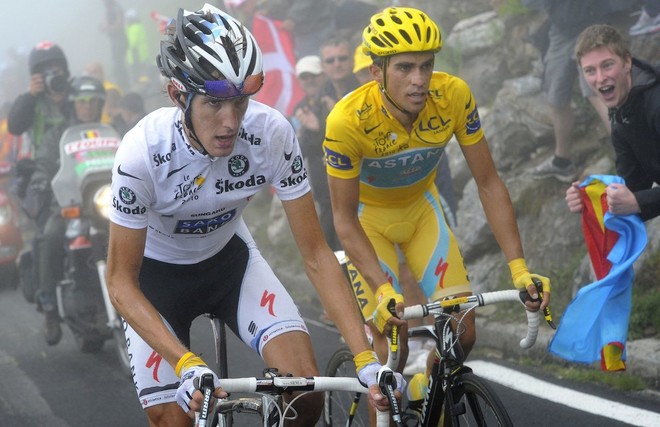
Ullrich cracks Armstrong… almost. Stage 13, 2003
If you’re still willing to acknowledge the Armstrong Tours – and have shreds of respect for the riders involved – there is plenty worth watching. If the pick of Armstrong’s rides came with ‘the look’ on Alpe d’Huez in 2001, then an obvious choice for a moment of fragility came on Stage 13 of the 2003 race.
It was the first Pyrenean stage following a spell in the Alps which the Texan did not have his own way. He still led the GC but with Jan Ullrich and Alexander Vinokourov within striking distance and a trio of exciting Euskatel-Euskadi riders on the rise. Ullrich’s newly assembled Bianchi squad led on the climb of the Port de Pailhères and were surprisingly successful in depleting Armstrong’s support. With just Manuel Beltran and a struggling Roberto Heras aside him, Armstrong was left relying on team-mate José Luis Rubiera who had been sent in the morning’s break for deferred support. The poker-faced champion was far from his most comfortable but Ullrich and friends had been duped before.
The fearless Euskatel riders made the tempo on the final climb and a large part of the peloton were found wanting. Soon only a small group remained but Armstrong’s hopes were bolstered when Rubiera dropped back from the break. Undeterred, rivals prepared to take shots at Armstrong with Haimar Zubeldia initiating the attacks. Ullrich was quick to follow whilst Armstrong and Vinokourov clawed their way across. Vinokourov had been promising to attack and launched inside 3km to go putting Armstrong on the ropes.
As with many great stages, there had been an additional battle at the head of the race with Carlos Sastre soloing up the Plateau de Bonascre (Ax 3 Domaines) to catch and pass compatriot Juan Miguel Mercado. The race contenders knew bonus seconds were up for grabs and set off in pursuit of the leaders. Vinokourov soon cracked but Ullrich and Zubeldia had left Armstrong and powered into the final kilometre. A relentless Ullrich stamped his way passed Mercado into second place realising his four-year ambition; he had finally distanced Armstrong. Sastre held strong to win the stage (cue his famous dummy celebration) as, at the age of 28, he was about to start the most glistening of back-loaded careers. One final twist was in store as Armstrong raced up the final slopes reducing his losses to a mere eight seconds and providing a reminder of the size of the task that faced Ullrich in the remaining stages. The German would ultimately fall short with an adrenaline-fuelled Armstrong winning the stage two days later after being brought down by a fan.
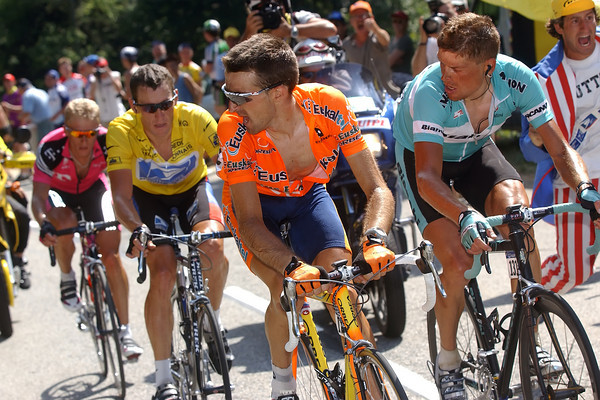
Pieter Weening and Andres Kloden go to a photo finish. Stage 8, 2005
In the spirit of not just choosing summit finishes, I turn to Pieter Weening and Andres Kloden’s successful escape in the 2005 Tour. Stage 8 of the race is a hidden gem with several riders going on the attack and just enough climbing to keep the GC contenders on their toes. The day started in Pforzheim, Germany, and wound through the Black Forest before returning to France. The likes of Michael Boogerd and Jens Voigt were involved in the early action with the former setting up Michael Rasmussen’s raid on the available KotM points. It was only after Thor Hushovd took the intermediate sprint that a settled group established containing Rabobank’s Weening and 20th placed Niki Sorensen.
When the gap reached 6 minutes, Armstrong’s Discovery Team began to pull things back. At the summit of the day’s final climb – the Col de la Schlucht – Weening went solo with the peloton hurtling along behind him. Armstrong had lost his team mates and Vinokourov attacked out of the chase group on two occasions. His first attack was shut down by a young Alejandro Valverde, the second by the Spaniard’s team mate Francisco Mancebo. Ninth placed Andres Kloden was next to make a move and he was successful in escaping from the group, catching Weening just prior to the summit of the climb. The two raced down the short descent to the stage’s finish working hard to maintain their 20 second gap over a determined peloton. The fresher Kloden was favourite for the sprint but also held GC ambitions and was hunting for time gains. The German lead his Dutch rival into the final kilometre and opened up the sprint early. Weening sat patiently on his wheel leaving it late to emerge from his slipstream. Neither rider had a fast sprint with the tall and skinny Weening looking particularly untidy as he rocked and rolled round the outside. He soon drew level with Kloden and the two lunged their bikes at the line leaving the result in doubt. In one of the closest finishes in Tour history, Weening was awarded the stage by 0.0002 seconds – his first win in his first Tour.
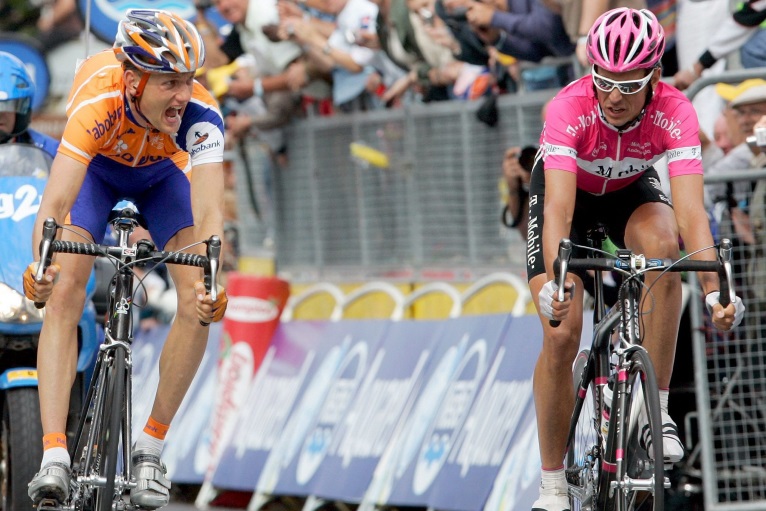
Andy Schleck vs. Alberto Contador. Stage 17, 2010
A perfect storm brewed in the 2010 Tour de France and one of the greatest modern-day rivalries culminated on the Tour’s most visited climb; the Col du Tourmalet. Contador had won the Tour in 2009 with Andy Schleck claiming second spot. A year on the gap had closed and Schleck’s season was built around a Tour de France challenge. After conceding time in the prologue, Schleck took the upper hand on Stage 3 getting into a small front split on a flat stage to Nord. He took a stage and the race lead in the Alps before his Tour was rocked on Stage 15. He attacked on the Porte de Bales and very obviously slipped his chain. Contador had already responded and rode away oblivious to the stranded Schleck. The Spaniard took the race lead by eight seconds leaving an angry and upset Schleck (yet still typically cool-headed) pondering how he could take a lead into the final time-trial.
On Stage 17 the riders headed down to the foot of Tourmalet with Schleck’s Saxo Bank chipping away at the peloton. Halfway up the monster climb Schleck surfaced at the front and took matters into his own hands. With just under 10km left he put in his attack and only Contador could follow. A few hundred metres later the peloton was a distant memory and it took just a kilometre to catch the remains of the day’s break and become the leaders on the road. The weather gradually got worse with rain followed by a thick mountain fog. At times it was difficult to spot the pair – Contador in all yellow and Schleck wearing the white of the race’s best young rider.
Contador’s often noted to be the rider most comfortable out of the saddle but the taller Schleck matched his style as he led up the climb. He never eased up, constantly looking back for the smallest of gaps or a weakness in his rival’s eyes. With just less than 4km to go Contador broke poise by surging up the inside of a right-hander and distancing Schleck, if only a little. Schleck responded well, dancing up behind Contador refusing to be broken. The moment – the only serious attack on the final slopes – seemed to go on forever before Schleck pulled up alongside Contador and gave him a famous stare. It said everything Schleck was feeling; anger, shock, satisfaction, acceptance. The two rode on as equals with Contador allowing Schleck the stage honours. They were actually reported as friends which made their battles at the 2010 Tour that bit more complicated.
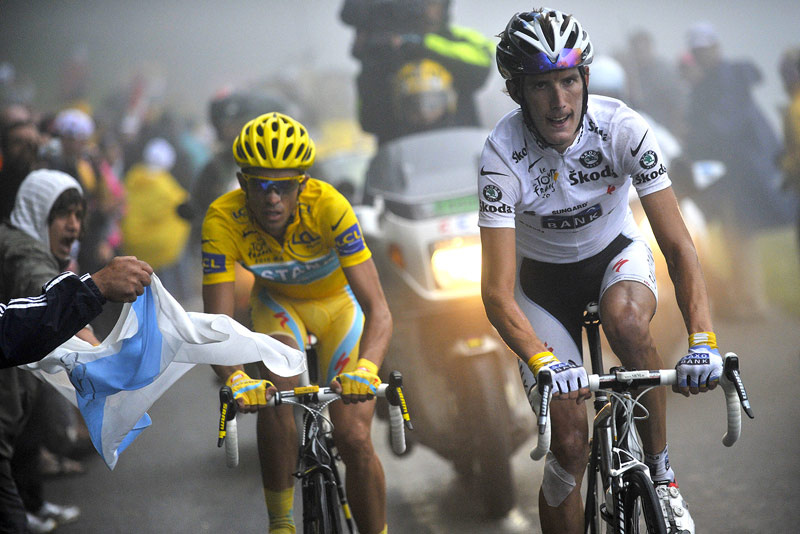
Andy Schleck works his magic. Stage 18, 2011
A year after his Tourmalet battle, Andy Schleck returned to the Tour to face a resurgent Cadel Evans. He would again fall short* in second place but not before carrying out one of the greatest planned attacks of all time. The 2011 race is one of my favourites with an evenly matched cast exchanging attacks behind a defiant French leader. The two stars – Evans and Schleck – were both looking for elusive Tour wins having been pipped by Spanish rivals in the races of 2008 and 2010. Giro champion Contador returned but would fade to fifth and later serve a suspension. Thomas Voeckler bettered his 2004 efforts by landing in yellow on Stage 9 and holding the jersey through the Pyrenees and until the final Alpine stage.
Schleck had threatened on occasion but sat fourth in the GC before the start of Stage 18, a minute behind Evans and needing to leapfrog him before the final time-trial; a familiar story. In the Leopard-Trek hotel room Schleck, Stuart O’Grady, Kim Anderson and Luca Guercilena devised a plan with a confident Schleck promising to attack early. Maxime Monfort – a key player – famously described it as ‘PlayStation cycling’. The day’s breakaway went early and Monfort bridged across to join a group that included Leopard’s Joost Posthuma. The gap to the peloton was maintained and their plan had been put into action.
On the Col d’Izoard, some 60km from the finish, Schleck attacked and the peloton froze. He raced up the early switchbacks and soon joined Posthuma who gave support until he reached his limit. Monfort was nearly at the summit and could afford to sit up whilst allowing Schleck to join him for the descent. The Belgian was a superior descender and took his leader down the winding corners. He was superb and continued to pace Schleck through the valley maintaining a two minute advantage. There were others in the group hunting lone leader Maxim Iglinsky and they worked well on the approach to the Col du Galibier. By contrast, the peloton was disorganized. Voeckler’s Europcar didn’t have the resources and Evans’ BMC were wary of Schleck’s older brother, Frank, who remained a threat. Everything that Leopard had premeditated had been accomplished with the feature climb still to come.
Schleck started confidently on the Galibier whilst Evans was reduced to a grind and could not escape Voeckler and Pierre Rolland. On the steep final slopes a lead which was once over three minutes was reduced to two and a half – a sign that Schleck was finally tiring. It was too little too late for Evans and a courageous Schleck put over two minutes into each of his stunned rivals with the most magnificent of victories. Astonishingly, Voeckler hung on to yellow by fifteen seconds finishing in a creditable fifth spot.
*Schleck was later awarded the 2010 Tour
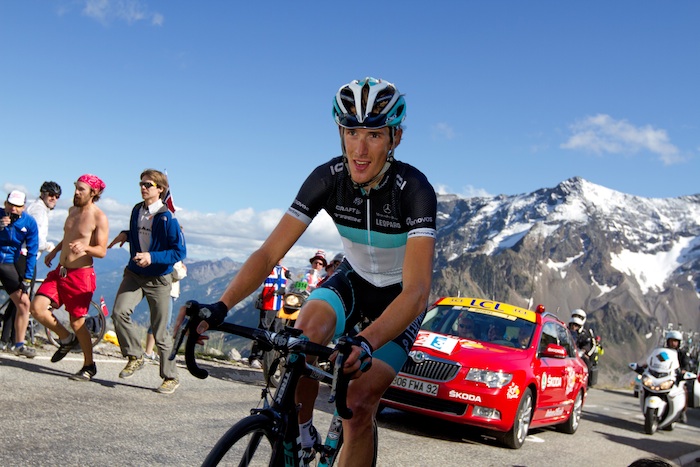
Nibali punishes his rivals on the cobbles. Stage 5, 2014
Before the 2014 Tour became ‘just’ a showcase for Vincenzo Nibali, it was a highly anticipated showdown which was blown apart in the opening week. Starting in Yorkshire, Marcel Kittel took the opening sprint stage before Nibali seized the yellow jersey with a brilliant attack in Sheffield. On Stage 5 the organizers had included a devilish cobbled stage – unpopular in some circles – that threatened to tear the peloton apart. Rain soaked Flanders and north France in the days before ensuring treacherous and muddy conditions. There were plenty of crashes in the early non-cobbled sections which ultimately lead to defending champion Chris Froome leaving the race. With the first cobbled section approaching, Peter Sagan’s Cannondale team tore off the front and put the peloton into the trouble. The first of many major splits occurred on the Carrefour de l’Arbre and the peloton would be fragmented into over 25 clusters by the day’s close.
By the second pavé sector Nibali had begun to make gains, able to follow accelerations by Belkin’s specialists Sep Vanmarcke and Lars Boom. The stage got no less attritional with rider after rider falling away from the rapidly dwindling lead group and new causalities every couple of kilometres. It made for quite a spectacle with the Tour having never got as close to an edition of Paris-Roubaix (and perhaps never will again). With every cobbled section there was a new acceleration – usually from the Belkin duo – and each time a mud-splattered Nibali, led by team mate Jakob Fuglsang, was fit to respond. A second team mate, Lieuwe Westra, dropped back from a doomed early break and Astana powered on over the brutal terrain. Everything went to plan for Nibali who resembled a highly skilled cobbles rider. Belkin’s Lars Boom would eventually break free for the stage win with Nibali finishing in third place and increasing his GC lead. He had ridden with a calmness that had been in stark contrast to his nervous and beaten rivals. The stage was incredible from the early kilometres and it was stunning to see the 193 finishers completely strung out. The cobbled stage is a destructive card but one the ASO will surely look to play again in the coming years.
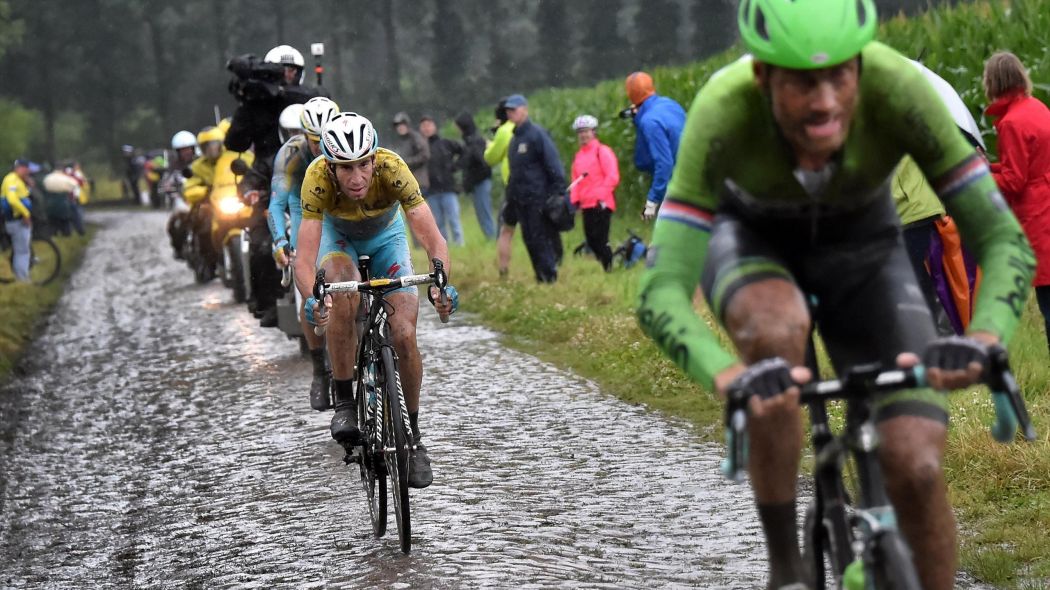
Part 1: Thevenet, Kuiper, Van Impe, Pelier, Roche, Delgado, Pantani
Reblogged this on Kite*Surf*Bike*Rambling and commented:
pt2 of this great post
LikeLike
Stage 5 in 2014 was certainly one to remember. The Tour meets Paris-Roubaix. Wow. And the rain and the mud and the crashes and the favorites in trouble. Loved it. Then the double Astana break away at the end while everything was so chaotic. Cycling at its bets, and with no mountains.
LikeLiked by 1 person
Agree – it was a wonderful stage. One of the best of the last few years. It destroyed the GC
LikeLike
Would have been nice with a stage like that this year, too. A little too many sprinter stages for my liking. 🙂
LikeLiked by 1 person